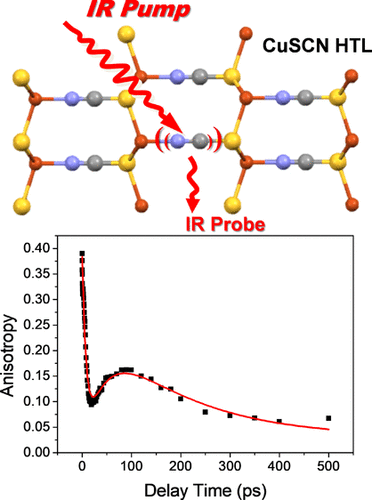当前位置:
X-MOL 学术
›
J. Phys. Chem. Lett.
›
论文详情
Our official English website, www.x-mol.net, welcomes your feedback! (Note: you will need to create a separate account there.)
Vibrational Relaxation Dynamics of a Semiconductor Copper(I) Thiocyanate (CuSCN) Film as a Hole-Transporting Layer.
The Journal of Physical Chemistry Letters ( IF 5.7 ) Pub Date : 2020-01-07 , DOI: 10.1021/acs.jpclett.9b03480 Xiaoqian Li 1 , Dexia Zhou 1 , Hongxing Hao 1 , Hailong Chen 2 , Yuxiang Weng 2 , Hongtao Bian 1
The Journal of Physical Chemistry Letters ( IF 5.7 ) Pub Date : 2020-01-07 , DOI: 10.1021/acs.jpclett.9b03480 Xiaoqian Li 1 , Dexia Zhou 1 , Hongxing Hao 1 , Hailong Chen 2 , Yuxiang Weng 2 , Hongtao Bian 1
Affiliation

|
The semiconductor CuSCN film, which is typically used as the hole-transporting layer (HTL) in solar cell studies, has been investigated by Fourier transform infrared (FTIR) spectroscopy and ultrafast transient infrared (IR) spectroscopy. A sharp peak at 2175 cm-1 corresponding to the CN vibrational stretching mode in CuSCN was observed, and the peak frequency remained unchanged by varying the thickness of the CuSCN thin film. Vibrational relaxation measurements showed that the 0-1 and 1-2 transitions of CN stretching can be observed at 2175 and 2140 cm-1, respectively. The heat-induced absorption and bleaching peaks (2167 and 2175 cm-1) can be clearly seen at a waiting time of 40 ps. The vibrational relaxation of the CN stretching mode determined from the 1-2 transition exhibited a biexponential decay with time constants of 7.4 ± 0.5 (90%) and 158 ± 50 ps (10%). Importantly, the abnormal anisotropy decay of the CN stretching mode in the CuSCN thin film was also observed for the first time. A detailed analysis showed that the distinct anisotropy decay curve could be described using a triexponential decay function, which was explained by three different processes: resonance energy transfer (∼8 ps), a thermalization process (∼40 ps), and molecular rotation (∼150 ps). The time scale of the thermalization process caused by the vibrational relaxation in CuSCN is at a time scale of 40 ps, which is important for us to understand the thermally activated charge-transport property of the CuSCN film employed as the HTL. Further UV pump-IR probe measurement revealed that the carrier scattering and relaxation processes in the CuSCN film are strongly associated with the vibrational excitation and relaxation dynamics of the CN stretching mode. It is expected that the fundamental understanding of the vibrational relaxation dynamics of the CuSCN thin film should provide helpful insight to elucidate its role as the HTL in solar cell studies at the molecular level.
中文翻译:

作为空穴传输层的半导体硫氰酸铜(I)薄膜的振动弛豫动力学。
半导体CuSCN膜通常在太阳能电池研究中用作空穴传输层(HTL),已经通过傅立叶变换红外(FTIR)光谱和超快瞬态红外(IR)光谱进行了研究。观察到在2175 cm-1处有一个锐峰,与CuSCN中的CN振动拉伸模式相对应,并且通过改变CuSCN薄膜的厚度,峰值频率保持不变。振动弛豫测量表明,可以分别在2175和2140 cm-1处观察到CN拉伸的0-1和1-2转变。在等待时间为40 ps时,可以清楚地看到由热引起的吸收峰和漂白峰(2167和2175 cm-1)。由1-2跃迁确定的CN拉伸模式的振动弛豫表现出双指数衰减,其时间常数为7.4±0。5(90%)和158±50 ps(10%)。重要的是,还首次观察到了CuSCN薄膜中CN拉伸模式的异常各向异性衰减。详细的分析表明,可以使用三指数衰减函数来描述独特的各向异性衰减曲线,这可以通过三种不同的过程来解释:共振能量转移(〜8 ps),热化过程(〜40 ps)和分子旋转(〜 150 ps)。由CuSCN的振动弛豫引起的热化过程的时间标度为40 ps,这对于我们了解用作HTL的CuSCN膜的热活化电荷传输性质非常重要。进一步的紫外泵浦-IR探针测量表明,CuSCN膜中载流子的散射和弛豫过程与CN拉伸模式的振动激发和弛豫动力学密切相关。预期对CuSCN薄膜的振动弛豫动力学的基本了解应该提供有用的见解,以阐明其在分子水平上作为HTL在太阳能电池研究中的作用。
更新日期:2020-01-08
中文翻译:

作为空穴传输层的半导体硫氰酸铜(I)薄膜的振动弛豫动力学。
半导体CuSCN膜通常在太阳能电池研究中用作空穴传输层(HTL),已经通过傅立叶变换红外(FTIR)光谱和超快瞬态红外(IR)光谱进行了研究。观察到在2175 cm-1处有一个锐峰,与CuSCN中的CN振动拉伸模式相对应,并且通过改变CuSCN薄膜的厚度,峰值频率保持不变。振动弛豫测量表明,可以分别在2175和2140 cm-1处观察到CN拉伸的0-1和1-2转变。在等待时间为40 ps时,可以清楚地看到由热引起的吸收峰和漂白峰(2167和2175 cm-1)。由1-2跃迁确定的CN拉伸模式的振动弛豫表现出双指数衰减,其时间常数为7.4±0。5(90%)和158±50 ps(10%)。重要的是,还首次观察到了CuSCN薄膜中CN拉伸模式的异常各向异性衰减。详细的分析表明,可以使用三指数衰减函数来描述独特的各向异性衰减曲线,这可以通过三种不同的过程来解释:共振能量转移(〜8 ps),热化过程(〜40 ps)和分子旋转(〜 150 ps)。由CuSCN的振动弛豫引起的热化过程的时间标度为40 ps,这对于我们了解用作HTL的CuSCN膜的热活化电荷传输性质非常重要。进一步的紫外泵浦-IR探针测量表明,CuSCN膜中载流子的散射和弛豫过程与CN拉伸模式的振动激发和弛豫动力学密切相关。预期对CuSCN薄膜的振动弛豫动力学的基本了解应该提供有用的见解,以阐明其在分子水平上作为HTL在太阳能电池研究中的作用。



























 京公网安备 11010802027423号
京公网安备 11010802027423号